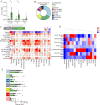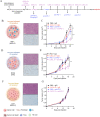Single-cell spatial landscape of immunotherapy response reveals mechanisms of CXCL13 enhanced antitumor immunity
- PMID: 36725085
- PMCID: PMC9896310
- DOI: 10.1136/jitc-2022-005545
Single-cell spatial landscape of immunotherapy response reveals mechanisms of CXCL13 enhanced antitumor immunity
Abstract
Background: Immunotherapy has revolutionized clinical outcomes for patients suffering from lung cancer, yet relatively few patients sustain long-term durable responses. Recent studies have demonstrated that the tumor immune microenvironment fosters tumorous heterogeneity and mediates both disease progression and response to immune checkpoint inhibitors (ICI). As such, there is an unmet need to elucidate the spatially defined single-cell landscape of the lung cancer microenvironment to understand the mechanisms of disease progression and identify biomarkers of response to ICI.
Methods: Here, in this study, we applied imaging mass cytometry to characterize the tumor and immunological landscape of immunotherapy response in non-small cell lung cancer by describing activated cell states, cellular interactions and neighborhoods associated with improved efficacy. We functionally validated our findings using preclinical mouse models of cancer treated with anti-programmed cell death protein-1 (PD-1) immune checkpoint blockade.
Results: We resolved 114,524 single cells in 27 patients treated with ICI, enabling spatial resolution of immune lineages and activation states with distinct clinical outcomes. We demonstrated that CXCL13 expression is associated with ICI efficacy in patients, and that recombinant CXCL13 potentiates anti-PD-1 response in vivo in association with increased antigen experienced T cell subsets and reduced CCR2+ monocytes.
Discussion: Our results provide a high-resolution molecular resource and illustrate the importance of major immune lineages as well as their functional substates in understanding the role of the tumor immune microenvironment in response to ICIs.
Keywords: Cytokines; Immunotherapy; Lung Neoplasms.
© Author(s) (or their employer(s)) 2023. Re-use permitted under CC BY-NC. No commercial re-use. See rights and permissions. Published by BMJ.
Conflict of interest statement
Competing interests: None declared.
Figures




References
Publication types
MeSH terms
Substances
Grants and funding
LinkOut - more resources
Full Text Sources
Medical
Research Materials
